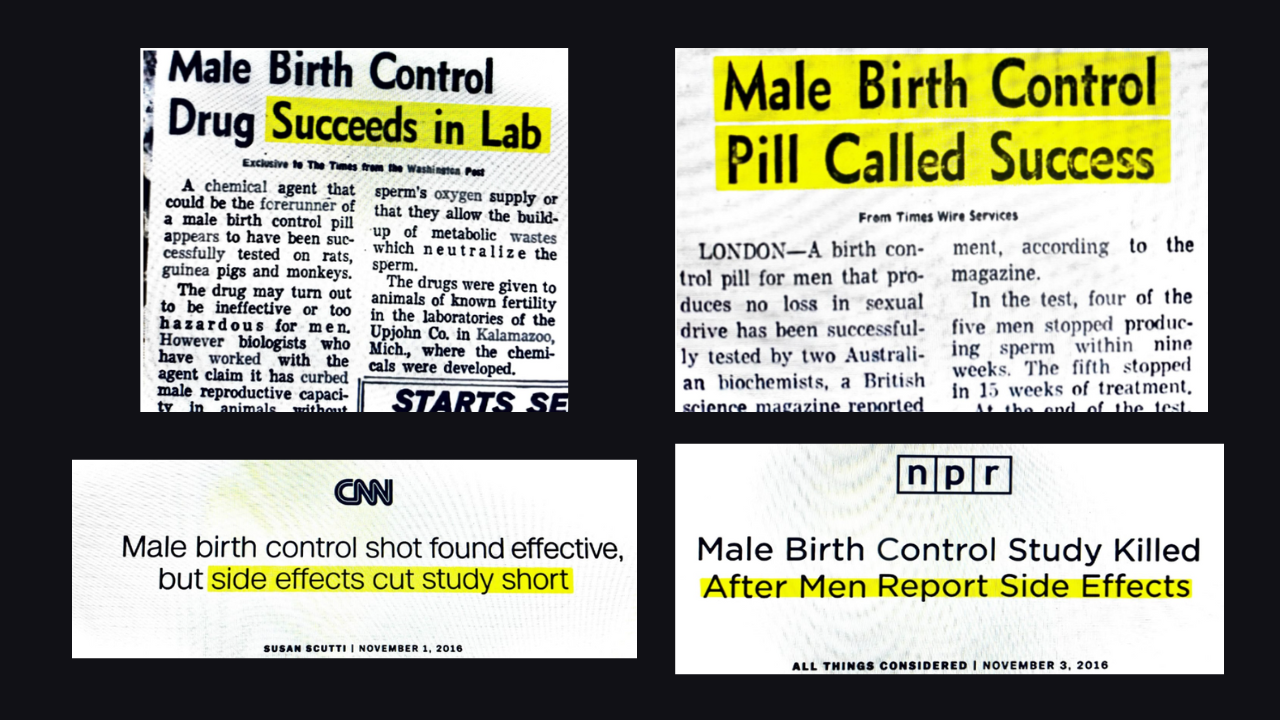- Health Conditions A-Z
- Health & Wellness
- Nutrition
- Fitness
- Health News
- Ayurveda
- Videos
- Medicine A-Z
- Parenting
Explained: The History Of Birth Control Pills And Other Alternative

Birth Control Pills contain synthetic hormones which stop ovulation. Often causing nausea, headaches, weight gain, and loss of libido. Higher doses of these synthetic hormones of estrogen may cause blood clots too.
The Dark Side Of Birth Control Pills
Before the pills were released in the market. It underwent human trials. Women who underwent the experiment were not aware of such a trial. A Netflix documentary Sex Explained, documents that in the 1960s. the US government’s initiative to control the population in developing countries through sterilisation allowed an inhumane experiment. Women in countries like Puerto Rico were given these birth control pills. The dosage of hormones was ten times the hormones that were actually required.
While the pill worked wonders, it also caused many women to face side effects, some were life-threatening. More than 10 years later, the cases were finally brought to the US government.
American author, feminist activist and journalist Barbara Seaman also covered the case and published a report called The Doctors' Case Against The Pill. The report mentioned that women who consumed these pills underwent many side effects, including heart attacks, strokes and cancer.
An all-male panel invited men to testify for the birth-control pills. The Netflix documentary notes that women were not heard for the case, as a response they invited themselves. “I would like to know why is that the scientists and drug companies are perfectly willing to use women as guinea pigs and experiment testing the higher estrogen, low estrogen content of the pill," said one of the women.
Finally, in 1980, a lower dose of the hormonal pill was released, however, the side effects still existed.
Intrauterine Device (IUD)
As the IUD hit the market, a new kind, known as the Dalkon Shield was also released in 1971. Loretta Ross- a black woman who had the Dalkon Shield inserted shared about her experience in the Netflix documentary.
For the first few months, the IUD worked, however, she started to develop some serious infections. Being a black woman, she was subjected to prejudices. Judged for “being available,” and thus the OB/GYN concluded that it was STI, despite the negative test results.
One night, she lapsed into a coma and she found herself to be in the hospital when she opened her eyes. The Dalkon Shield was removed because it had a design flaw. Its thick string worked as a ladder for bacteria to climb into her uterus, resulting in serious infections.
While the shield was pulled out of the market in 1975, 3.3 million women had already used it by then, with 18 reported deaths.
It was also revealed that the makers knew about the design flaw six months before the release.
Male Birth Control Pills

The idea of male contraception was also discussed and by 1970s, there were some promising news about it. Times Wire Services reported that a birth control pill for men was found that caused "no loss in sexual drive." It was successfully tested by two Australian biochemists. "In the test, four of the five men stopped producing sperm within nine weeks. The fifth stopped in 15 weeks of treatment," the report read.
However, as the studies went on till 2018, the pill never made it to market. In November 2016, Susan Scutti reported in CNN that the study was cut short due to the side effects of the pill. The report Male birth control shot found effective, but side effects cut the study short. Another report by NPR titled Male Birth Control Study Killed After Men Report Side Effects also seconded the claim.
While for women, those who are on birth control pills are prone to headaches, breast tenderness, acne, nausea, weight gain, irregular menstruation, mood changes, and decreased libido.
Could Bird Flu Become The Next Pandemic For Humans?

Credits: iStock
Bird flu viruses have been present for long, and what was earlier understood as a virus just limited to avian, could now affect humans too. Bird flu viruses could have a potential risk for humans and may become next pandemic. This comes from two different studies, one done by the universities of Cambridge and Glasgow that show how avian flu strains are multiplying even when the body temperatures could hinder viruses. Whereas, another important study led by Indian scientists, by Philip Cherian and Gautam Menon of Ashoka University, published in BMC Public Health predict if H5N1 or the bird flu virus, could start spreading among humans. How quickly must we act to stop it?
How Was The Study Conducted?
Using BharatSim, an open-source simulation platform originally developed during Covid-19, the researchers recreated what an outbreak might look like in real life. “The threat of an H5N1 pandemic in humans is a genuine one,” Prof Menon said, “but we can hope to forestall it through better surveillance and a more nimble public-health response.”
Their model begins where experts believe a real outbreak would: with a single human infection, most likely a poultry worker or someone exposed to infected birds at a farm or market. The danger, the researchers argue, lies not in that first case, but in whether sustained human-to-human transmission takes hold.
The Cambridge and Glasgow study also provides that the viruses generally replicates most effectively in the upper respiratory tract, where temperatures are around 33 °C. They replicate less efficiently deeper in the lungs, where temperatures rise to about 37 °C. However, avian flu thrives in hotter environments, which can read up to 40 to 42 °C.
Why Does Timing Matter More Than Anything Else?
The study by Ashoka University has the most sobering findings in how fast control can slip away. According to the simulations, once cases rise beyond roughly two to ten people, the virus is likely to move beyond immediate contacts and into the wider community.
If households of close contacts are quarantined when just two cases are detected, the outbreak can almost certainly be contained. By the time ten cases are identified, however, the model suggests the infection has probably already spread far enough that early interventions no longer make a meaningful difference.
To ground their work in reality, the researchers focused on a village in Tamil Nadu’s Namakkal district, one of India’s largest poultry hubs. With more than 1,600 farms, around 70 million chickens and tens of millions of eggs produced daily, the region reflects the kind of dense human-animal interaction where spillovers are most likely.
In the simulation, the virus spreads outward from a single workplace into homes, schools and markets, tracking primary and secondary contacts. Once “tertiary” infections, contacts of contacts, appear, control becomes dramatically harder without severe measures such as lockdowns.
What Works And What Does Not Work
Culling birds work, but only if it happens before humans are infected. Once the spillover is done, isolating patients and quarantining is the only option that can stop the virus, that too if done very early. Targeted vaccination could help raise the threshold at which the virus can sustain itself. Quarantine imposed too early keeps families together longer, increasing household transmission. Imposed too late, it barely slows the outbreak at all.
Why Is It Important To Understand How Avian Flu Works?
Avian flu, bird flu or the H5N1 is not new. It first appeared in humans in China in the late 1990s and has since become entrenched across South and South-East Asia. Most of the time, it remains a disease of birds. But every so often, it spills over.
Between 2003 and August 2025, the World Health Organization recorded 990 human infections across 25 countries. Nearly half of those infected died, a fatality rate of around 48%. The numbers are small, but the severity is striking.
In recent years, the virus has shown an unsettling ability to cross species barriers. In the United States, H5N1 has affected more than 180 million birds, spread to over 1,000 dairy herds across 18 states, and infected at least 70 people, most of them farmworkers. In India, the virus killed three tigers and a leopard at a wildlife rescue centre in Nagpur earlier this year, a reminder that mammals are increasingly getting caught in its path.
Fact Check: Are Nicotine Pouches Safer Than Smoking?

Credit: iStock
Nicotine pouches have become popular in the UK, show many studies, this is especially true in the case of young adults.
In fact, a new study done by the researches from University College London (UCL) has found that in the last five years, there has been an increase from 0.1 per cent to 1 per cent of adults using nicotine pouches. This means, around 522,000 more people in the UK have started using the pouches.
How Does A Nicotine Pouch Work?
The pouches are placed between the lip and gum and it releases nicotine slowly. The pouches are also available in variety of flavors, with sweeteners and plant-based fibers. It does not contain tobacco like vapes do and usually are considered to be a healthier alternative to smoking.
Health and Me ran a fact check on whether it truly is safer than smoking, and here is what we found.
Are Nicotine Pouches Safer Than Smoking?
"This risks are substantially less than some other nicotine products like smoking, because there is no tobacco and there is no combustion," said Dr Harry Tattan-Birch, the lead author of the study, to Mornings with Ridge and Frost.
"And we know the combustion of tobacco is the thing that causes most of the diseases related to smoking," he says.
However, he and his team has warned that while it may not cause serious illness like tobacco can, young people could have a negative impact in their lungs and brains, as they are still in developing stage. This makes them more sensitive to the effects of nicotine, and it could become difficult to stop using it.
A UCL research fellow earlier told Sky News that while nicotine pouches are far less harmful than smoking, their long-term effects remain unclear because they are relatively new. Drawing on what is known about their contents, she noted they are not risk-free, as users are still exposed to some toxic substances, albeit at much lower levels.
Who Are Using These Nicotine Pouches?
Researchers from UCL, supported by Cancer Research UK, analysed survey responses from 127,793 people aged 16 and above across England, Scotland and Wales, collected between October 2020 and March 2025.
Their analysis showed that nicotine pouch use among 16 to 24-year-olds rose to 4% in 2025, up from just 0.7% in 2022. The increase was most pronounced among young men, with one in 13 men in this age group, or 7.5%, reporting use.
Overall, men accounted for 72% of nicotine pouch users between 2022 and 2025, while 47% were under the age of 25. Dr Tattan-Birch said the growth in use has been driven almost entirely by young people, particularly young men, with usage among adults over 35 remaining low and largely unchanged.
He added that this trend also includes children. Since nicotine pouches are not classified as tobacco or vape products, there are currently no age limits. Advertising is also unrestricted, allowing brightly coloured, sweet-flavoured products to appeal to younger audiences.
Do Nicotine Pouches Help Quit Smoking?
The research found that 69 per cent of pouch users were reported using other nicotine products, while 56 per cent of them smoked, as per the survey from January 2022 to March 2025.
1 in 6, which makes it 16 per cent said they never regularly smoked. "Whether nicotine pouches are good or bad for public health depends on who is using them. If it's a young person who would otherwise start smoking, then the use of pouches might help to reduce harm. However, if it's a person who otherwise would not use nicotine at all, then the potential for harm increases," said Tattan-Birch.
Can A Cyst Grow Teeth And Hair Inside The Body? Everything You Need To Know About Dermoid Cysts

Credits: canva
A woman experiencing abdominal discomfort went to her gynecologist for an ultrasound, only to discover something far more startling than a baby. The mom, who shares her story on TikTok under the handle @sandwitchbread, revealed her medical surprise in a video that has now amassed over 1.9 million views. She said she had been struggling with pain and unusual bleeding since giving birth to her two-year-old son and decided to see a gynecologist fearing she might be pregnant again.
During the ultrasound, she noticed something on the screen, but the doctor quickly reassured her it wasn’t a baby. “When my doctor came in to share the results,” the TikToker recalled, “she looked me in the eyes and told me I had a seven-centimeter cyst, about the size of a chicken egg, called a dermoid cyst.”
What Is A Dermoid Cyst?
A dermoid cyst is a pocket of tissue growth that can contain normal body tissues, sometimes including hair, fluid, teeth, or skin. While this TikToker’s cyst was in her uterus, dermoid cysts are most commonly found in the ovaries. They are generally harmless but often require surgical removal. According to the National Cancer Institute, dermoid cysts are present from birth but may not be detected until later in life. These benign tumors originate from embryonic cells that become “trapped” and develop into tissues in the wrong location. Teeth and hair are frequent components, and surgery is usually recommended if the cyst causes symptoms or complications.
Why Do Dermoid Cysts Have Hair and Teeth?
Dermoid cysts develop hair and teeth because they arise from trapped embryonic cells (ectoderm) that can grow into skin, hair follicles, sweat glands, and even teeth, instead of forming the tissues normally found in the ovary or skin. Essentially, they are benign tumors made up of mature but misplaced body tissues from the outer layer of the embryo, which normally forms skin and related structures.
Dermoid Cysts: Symptoms
Most ovarian dermoid cysts remain symptom-free unless complications occur. When symptoms do appear, the most common one reported is lower abdominal pain.
As the cyst enlarges, it can cause noticeable abdominal swelling and problems with the urinary or digestive system.
In more severe cases, individuals might also experience:
- Fever
- Intense abdominal pain
- Unusual vaginal bleeding
- Unexplained weight loss
The Office on Women’s Health notes that cysts on the ovaries can also cause:
- Pressure in the abdomen
- Bloating
- Abdominal swelling
- Pain in the lower abdomen
Dermoid Cysts: Possible Complications
Some potential complications include:
Rupturing of the cyst: Though rare, ovarian dermoid cysts can burst. If the cyst’s contents leak into the abdominal cavity, it may lead to chronic inflammation of the abdominal lining (peritonitis). In some cases, leakage into the intestines or rectum can result in the material being expelled through the anus.
Ovarian torsion: This occurs when the cyst twists the ligaments holding the ovary in place, which can cut off blood supply to the ovary and fallopian tube.
Infection: The risk of infection is around 1–4%. Severe infections may lead to cyst rupture.
Malignant transformation: Dermoid cysts are almost always benign, but in rare instances, they can become cancerous.
© 2024 Bennett, Coleman & Company Limited

